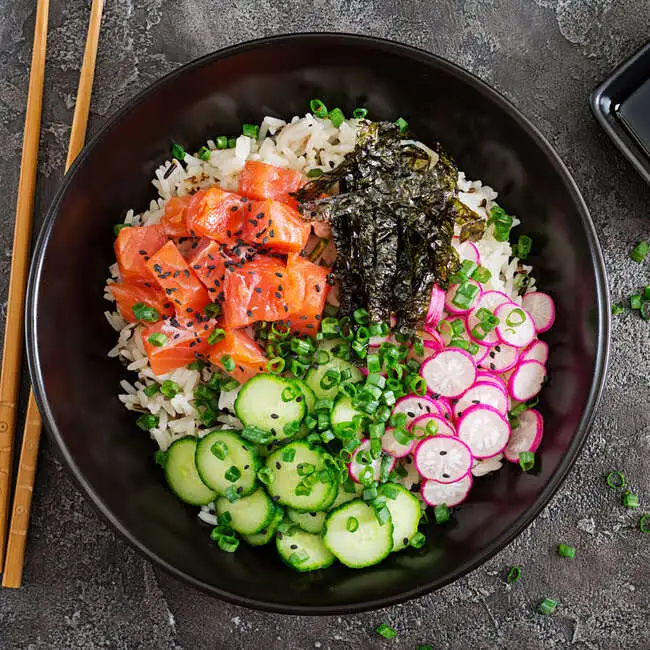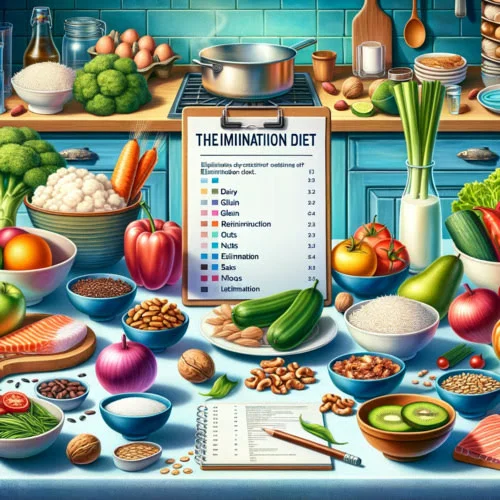Greetings, dear readers! Today, I want to share my experience and knowledge in the field of dietetics, specifically discussing the benefits and characteristics of the Asian diet. This dietary approach attracts attention with its unique concept based on traditional principles of Asian cuisine. Let’s dive together into the world of taste, balance, and health that the Asian diet offers.
| Pros (+) | Cons (-) |
|---|---|
| Promotes balanced and diverse nutrition | May not deliver rapid weight loss results |
| Emphasizes healthy grains and vegetables | Slow weight loss pace may disappoint some individuals |
| Moderate consumption of animal fats | Adherence to diet rules may be challenging |
| Green tea contributes to fat burning | Specific requirements and restrictions can be complex |
| Rich in essential nutrients | Not recommended during pregnancy and breastfeeding |
| Supports long-term health improvement | May require modification for individuals with certain health conditions |
| Gradual and stable weight loss | |
| Reflects a holistic lifestyle approach |
The first question that might come to your mind is, “Why the Asian diet?” Well, let’s take it step by step. This method of eating not only promises weight loss but also serves as a genuine exploration of how to bring your diet into balance. It’s not just about losing weight; it’s about creating a new lifestyle that supports your body in health and energy.
For those aiming for harmony in their diet, the Asian diet offers several key commitments. The first and foremost is a balanced diet. Here, you won’t find radical restrictions or stress for the body. The diet is based on the diversity of foods that not only bring pleasure with their taste but also enrich your body with everything it needs. Let’s explore these principles together and lay the foundation for a healthy and delicious diet.
Key Principles of the Asian Diet
In the world of the Asian diet, each principle is not just a dietary rule but a lifestyle filled with traditions and care for health. The main principle is harmony and balance in everything, from choosing products to their combination on the plate. It’s not just a diet; it’s a path to a long and healthy life based on self-respect and respect for the surrounding world.
The most crucial principle of the Asian diet is a balanced diet. Here, you are not restricted in foods but encouraged to embrace diversity. Proteins, carbohydrates, fats – everything should be in harmony. Imagine your lunch or dinner as a colorful palette, where each product contributes to the overall picture of your health. A balanced diet is not just a diet; it’s a lifestyle where your body receives all the necessary substances to sustain its functions.
If you thought rice is the only main character in the Asian diet, you’re right! But please, don’t limit yourself to just white rice. Variety of grains is highly appreciated here. From fiber-rich brown rice to quinoa and buckwheat – each grain brings its benefits. Try incorporating different types of grains into your diet and feel how your body thanks you for this colorful bouquet.
Another interesting aspect of the Asian diet is the approach to vegetables. Instead of consuming them raw, as often suggested in other diets, the Asian method insists on cooking them. The reason is simple: boiled vegetables are easier to digest and better absorbed by the body. This approach reduces the burden on the digestive system and gives you more benefits from the vitamins and minerals present in vegetables.
If you’re a meat lover, don’t worry. The Asian diet doesn’t advocate complete avoidance of animal fats; it suggests moderation. Chicken, turkey, fish – these are your reliable allies. However, red meat such as lamb or beef is recommended to be minimized in the diet. This approach supports heart and vascular health, preventing an excess of saturated fats in the body.
Let’s conclude this culinary guide to the Asian diet with green tea. This beverage is not just popular in Asia – it is a key element of the diet. Green tea speeds up metabolism, promotes fat burning, and serves as a source of beneficial antioxidants. Rich in vitamins and amino acids, this drink helps strengthen the nervous system and supports bone health. Don’t forget to add a cup of green tea to your diet – your body will thank you.
Asian Diet Menu
Let’s explore together how your day could look following the Asian diet. This meal plan will not only satisfy your hunger but also provide a sense of lightness and energy throughout the day. Are you ready to immerse yourself in the world of flavors and nutritious foods?
Cooking Guidelines in the Asian Diet
Cooking in the Asian diet is not just about preparing food; it’s a whole ritual of self-care. Forget about frying and excessive oil. Prefer boiling, steaming, and minimal additives. Soy sauce, spicy and flavorful seasonings like pepper, curry, garlic, and ginger, will be your faithful companions in preparing exquisite dishes. Allow each ingredient to unfold its taste while preserving all its beneficial properties. Cook with love and inspiration, making every meal a true celebration for your body.
Contraindications of the Asian Diet
Before diving into the world of the Asian diet, it’s essential to be aware of your current health condition. If you have chronic illnesses or are undergoing specific treatments, consultation with a doctor is necessary. For example, if you have serious kidney or liver problems, the Asian diet may require adjustments to meet your needs. Also, if you are prone to allergies to certain products, carefully examine the composition of the diet to avoid unwanted reactions.
The Asian diet, despite its beneficial principles, may not be suitable during pregnancy and breastfeeding. It is crucial to provide the body with all the necessary nutrients required to maintain the health of both you and your baby. For children, teenagers, and the elderly, it is also recommended to vary the diet to ensure all necessary elements for healthy growth and development. In the case of pregnancy or breastfeeding, as well as for children and teenagers, it is better to choose more diverse eating methods.
Creating a diet in the Asian diet requires attention to your current health condition. If you have issues with the cardiovascular system, it is essential to regulate the intake of animal fats, especially red meat. People with gastrointestinal problems are advised to monitor the consumption of spices and hot seasonings. If you have an allergy to certain products, replace them with safe alternatives. Health should always be a top priority, even when following a diet.
Advantages of the Asian Diet
The Asian diet is not just a passing trend; it has gained support from modern dieticians. Many experts highlight its balanced and diverse approach to nutrition, aligning with the basic principles of a healthy lifestyle. Avoiding excess animal fats, moderate meat consumption, and a preference for natural sources of nutrients make this dietary method appealing to professionals.
One of the notable advantages of the Asian diet is balance in the diet. The combination of various foods, such as rice, vegetables, fish, and green tea, provides the body with essential macro- and micronutrients. The richness of vitamins, minerals, and antioxidants includes not only crucial nutritional elements but also contributes to overall health.
The Asian diet doesn’t promise instant results, but what it offers is gradual and steady weight loss. This approach is considered healthier and more long-term. Gentle weight reduction is usually accompanied by an improvement in the overall condition of the body and does not create stress for metabolism.
Key products of the Asian diet, such as brown rice, fish, seaweed, and soy products, have outstanding nutritional properties. For instance, brown rice is rich in B vitamins and zinc, while soy products provide an alternative to dairy products containing easily digestible calcium. All of this contributes not only to weight loss but also to overall health.
Disadvantages of the Asian Diet
One of the main drawbacks of the Asian diet is that it is not designed for those seeking rapid and drastic weight loss results. This dietary method suggests gradual and moderate weight reduction, which may not align with the expectations of people looking for quick effects.
Associated with the first drawback, the slow pace of weight loss can be disappointing for those aiming to shed extra pounds quickly. The weight loss rate on the Asian diet may be too slow for those who wish to see results in the short term.
Another drawback is the specificity of the requirements and restrictions of this diet. Some people may find it challenging to adhere to rules related to the choice and preparation of specific foods, as well as the limitation of the consumption of certain food categories. This can pose additional difficulties in maintaining long-term commitment to this dietary method.
Repeating the Asian Diet
If you feel good and have achieved your desired weight, you can repeat the Asian diet at any time. This approach allows you not only to maintain your current weight but also to continue enjoying the benefits of a balanced Asian-style diet.
To maintain the achieved results after the Asian diet, it is essential to adhere to the basic principles of this dietary method. It is crucial to maintain a balanced diet, including a variety of grains, vegetables, fish, and other key foods. Gradually increasing calorie intake and portion sizes will also help maintain weight at the desired level.
When repeating the Asian diet, consider the individual needs of your body. You may need to slightly modify the diet, taking into account changes in physical activity, lifestyle, and overall health. The key is to maintain balance and follow the general principles of Asian nutrition to sustain the achieved results.
Conclusion
In conclusion, the Asian diet represents a unique approach to nutrition based on balance, variety, and care for health. The fundamental principles of this diet, such as a balanced diet, diverse grains, vegetables, and moderate consumption of animal fats, lay the foundation for a healthy lifestyle.
By studying the principles and recommendations of the Asian diet, one can conclude its effectiveness for those who value gradual and steady weight loss. The richness of essential nutrients in the key products of this diet supports health and provides the body with necessary nutrients.
For successful implementation of the principles of the Asian diet into everyday life, it is recommended to start gradually introducing key foods and adapting to new eating habits. Remembering individual body characteristics and adjusting the diet to your needs is crucial. Gradual changes in dietary habits, considering the basic principles of the Asian diet, can lead to long-term health improvement and maintaining stable weight.
FAQ
– The Asian diet prioritizes a balanced diet that includes a variety of foods, supporting overall health.
– Diversity in grains, such as brown rice, oats, buckwheat, and quinoa, ensures the body receives essential nutrients.
– The Asian diet suggests preferring cooked vegetables over raw ones for easier digestion and improved absorption of beneficial nutrients.
– The diet advocates for moderate consumption of meats like chicken and fish while regularly incorporating soy products instead of animal fats.
– Green tea accelerates fat burning, enhances the nervous system, and possesses other positive properties.
– A typical menu includes dishes like rice, miso soup, fish, vegetables, fruits, soy milk, and green tea.
– The Asian diet is not recommended during pregnancy, breastfeeding, for children, and adolescents. Individuals with chronic conditions should consider their health when choosing this diet.














